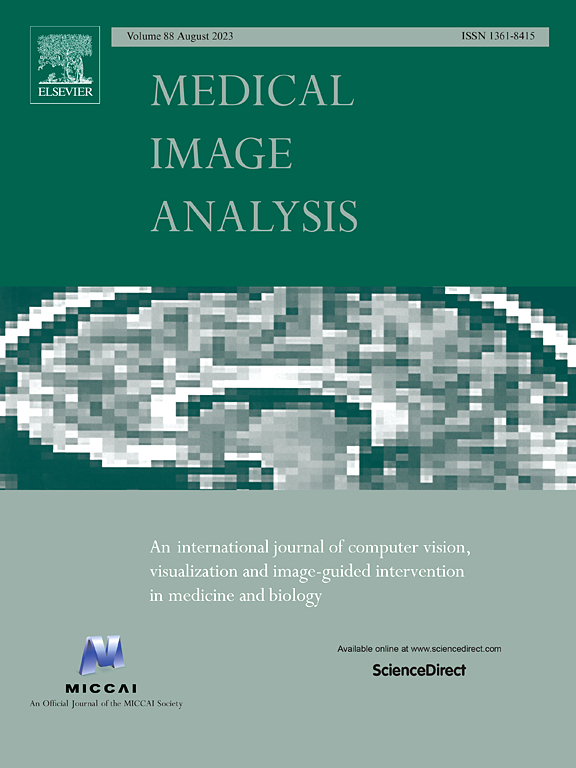DeepResBat: Deep residual batch harmonization accounting for covariate distribution differences
IF 10.7
1区 医学
Q1 COMPUTER SCIENCE, ARTIFICIAL INTELLIGENCE
引用次数: 0
Abstract
Pooling MRI data from multiple datasets requires harmonization to reduce undesired inter-site variabilities, while preserving effects of biological variables (or covariates). The popular harmonization approach ComBat uses a mixed effect regression framework that explicitly accounts for covariate distribution differences across datasets. There is also significant interest in developing harmonization approaches based on deep neural networks (DNNs), such as conditional variational autoencoder (cVAE). However, current DNN approaches do not explicitly account for covariate distribution differences across datasets. Here, we provide mathematical results, suggesting that not accounting for covariates can lead to suboptimal harmonization. We propose two DNN-based covariate-aware harmonization approaches: covariate VAE (coVAE) and DeepResBat. The coVAE approach is a natural extension of cVAE by concatenating covariates and site information with site- and covariate-invariant latent representations. DeepResBat adopts a residual framework inspired by ComBat. DeepResBat first removes the effects of covariates with nonlinear regression trees, followed by eliminating site differences with cVAE. Finally, covariate effects are added back to the harmonized residuals. Using three datasets from three continents with a total of 2787 participants and 10,085 anatomical T1 scans, we find that DeepResBat and coVAE outperformed ComBat, CovBat and cVAE in terms of removing dataset differences, while enhancing biological effects of interest. However, coVAE hallucinates spurious associations between anatomical MRI and covariates even when no association exists. Future studies proposing DNN-based harmonization approaches should be aware of this false positive pitfall. Overall, our results suggest that DeepResBat is an effective deep learning alternative to ComBat. Code for DeepResBat can be found here: https://github.com/ThomasYeoLab/CBIG/tree/master/stable_projects/harmonization/An2024_DeepResBat.
DeepResBat:考虑协变量分布差异的深度残差批量协调。
汇集来自多个数据集的磁共振成像数据需要进行协调,以减少不希望出现的站间变异,同时保留生物变量(或协变量)的影响。流行的协调方法 ComBat 采用混合效应回归框架,明确考虑了不同数据集的协变量分布差异。此外,基于深度神经网络(DNN)(如条件变异自动编码器(cVAE))开发协调方法也备受关注。然而,目前的 DNN 方法并未明确考虑不同数据集的协变量分布差异。在此,我们提供了数学结果,表明不考虑协变量会导致次优协调。我们提出了两种基于 DNN 的协变量感知协调方法:协变量 VAE(coVAE)和 DeepResBat。coVAE 方法是 cVAE 的自然扩展,它将协变量和站点信息与站点和协变量不变的潜在表征结合在一起。DeepResBat 采用了受 ComBat 启发的残差框架。DeepResBat 首先用非线性回归树消除协变量的影响,然后用 cVAE 消除站点差异。最后,将协变量效应加回统一残差。通过使用来自三大洲的三个数据集,共 2787 名参与者和 10085 次解剖 T1 扫描,我们发现 DeepResBat 和 coVAE 在消除数据集差异方面优于 ComBat、CovBat 和 cVAE,同时增强了感兴趣的生物效应。然而,coVAE 会在解剖磁共振成像和协变量之间产生虚假关联,即使在不存在关联的情况下也是如此。未来提出基于 DNN 的协调方法的研究应注意这一假阳性陷阱。总之,我们的研究结果表明,DeepResBat 是一种有效的深度学习方法,可以替代 ComBat。DeepResBat 的代码可在此处找到:https://github.com/ThomasYeoLab/CBIG/tree/master/stable_projects/harmonization/An2024_DeepResBat。
本文章由计算机程序翻译,如有差异,请以英文原文为准。
求助全文
约1分钟内获得全文
求助全文
来源期刊

Medical image analysis
工程技术-工程:生物医学
CiteScore
22.10
自引率
6.40%
发文量
309
审稿时长
6.6 months
期刊介绍:
Medical Image Analysis serves as a platform for sharing new research findings in the realm of medical and biological image analysis, with a focus on applications of computer vision, virtual reality, and robotics to biomedical imaging challenges. The journal prioritizes the publication of high-quality, original papers contributing to the fundamental science of processing, analyzing, and utilizing medical and biological images. It welcomes approaches utilizing biomedical image datasets across all spatial scales, from molecular/cellular imaging to tissue/organ imaging.
 求助内容:
求助内容: 应助结果提醒方式:
应助结果提醒方式:


